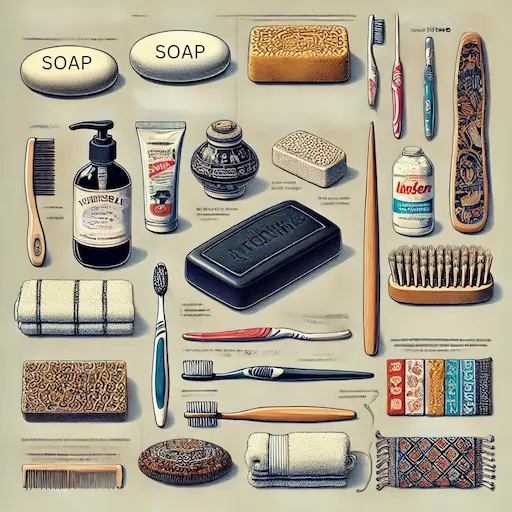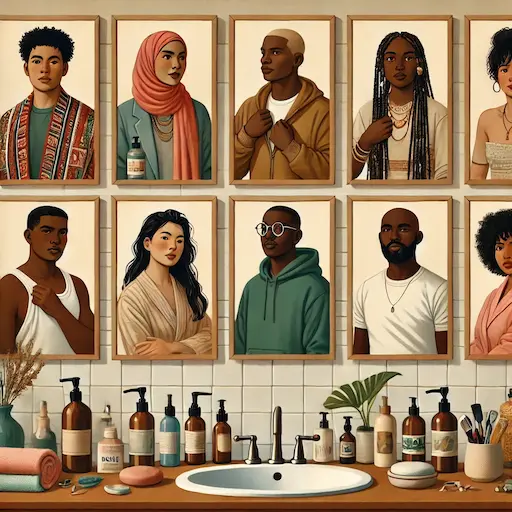How Cultural Beliefs Shape Hygiene Habits: Unique Perspectives Worldwide

Do cultural beliefs shape hygiene habits? Definitely! Each society has its own hygiene practices that reflect unique values.
What one culture sees as important may seem strange to another. These habits shape how people care for themselves and interact with others.
From handwashing rituals to how often people bathe, each culture’s approach to hygiene shows us something about its history and way of life.
Noticing these differences can help us build respect and have meaningful talks about global health.
As you think about these practices, consider your own habits and how they may come from tradition. This can let you share your own practices with others too.
Understanding Hygiene: What It Is and What It Isn't
Hygiene is more than just staying clean – it’s about staying healthy by stopping the spread of germs.
Hygiene means washing hands, bathing, and properly getting rid of waste to prevent the spread of harmful germs so we don’t get sick.
But it’s not just about routines; it also reflects personal and cultural ideas of what it means to be clean and healthy.

Some people see hygiene as strict standards of cleanliness, but it isn’t the same for everyone.
What one culture sees as essential hygiene may not be as important to another.
For example, hygiene can include things like grooming habits, handling food, and keeping the home clean (enviromental hygiene). It can also include rituals that focus on health and spirituality.
Understanding this broader view of hygiene helps us see its role in cultural identity and global health.
Cultural Perspectives on Hygiene Standards
In Japan, removing shoes before entering a home is linked to cleanliness and respect, In Japan, taking off shoes before entering a home shows respect and keeps things clean.
In India, traditional skincare routines using turmeric reflect a focus on natural hygiene.
What one culture sees as clean might seem unusual to another. For example, while many Western cultures use soap for handwashing, some cultures prefer to use just water.
Cultural practices also extend to menstrual health, with unique traditions around the world influencing how menstrual hygiene is viewed and managed, reflecting diverse approaches to personal care and cleanliness.
This choice is often about ritual purity instead of removing germs.
These factors shape cultural hygiene practices:
- Religious Influence: Many cultures have hygiene habits tied to religious beliefs, like washing before prayer.
- Resource Availability: Access to water and soap can vary by region, influencing hygiene practices.
- Social Norms: What’s considered polite or rude in terms of cleanliness depends on societal standards.
By learning about these cultural views, we can better understand and appreciate the different ways people around the world stay clean.

Personal Hygiene and Its Cultural Roots
Personal hygiene is more than a daily habit—it shows a person’s culture and traditions.
Bathing, grooming, and caring for nails are often learned from family and shaped by local customs and expectations.
Different cultures have their own unique hygiene habits:
- Bathing: In Scandinavian countries, saunas are important for hygiene and relaxation. In parts of Africa and Asia, communal baths emphasize community life.
- Grooming: Beards, hairstyles, and the use of makeup can show cultural identity and belonging.
- Oral Hygiene: In the West, flossing and brushing are common. In other places, people use natural tools like neem sticks or charcoal.
Beyond daily habits, many cultures use baking soda and other natural remedies for hygiene.
While these can be helpful, it’s important to know how they affect the body, especially in areas where pH balance is important.
Even if some cultures don’t focus on pH, understanding these effects helps us make safer choices.
Personal hygiene is influenced by different cultures, which helps us appreciate and respect other practices.

Is Hygiene Cultural? Myths, Misconceptions, and Facts
Hygiene isn’t just about keeping clean; it’s closely tied to cultural practices and traditions.
Factors like geography, climate, and historical influences shape how societies perceive cleanliness.
As we look at whether hygiene is cultural, it’s important to separate myths from facts so we can understand these different practices better.
Myths and Misconceptions About Hygiene Across Cultures
Many people think hygiene is the same everywhere. They believe all cultures have the same standards, which can lead to stereotypes.
Another idea is that some cultures don’t have hygiene standards at all. This can cause unfair judgments based on how someone looks or smells.
These beliefs come from not fully understanding other cultures. Often, the media and old stories exaggerate these cultural differences.
Challenging Stereotypes and Biases
Stereotypes about hygiene can be harmful. For example, some people think that if someone has bad teeth, they must be from a certain place.
But they don’t consider that dental care might not be available or that people have different views on caring for teeth.
Others might connect certain smells, like garlic or fried foods, to specific ethnic groups, which can lead to unfair judgments.
Another idea is that people who don’t wash their hair often are unclean.
However, hair care routines vary based on hair type, climate, and culture. In fact, washing hair less often can be healthier for some.
When I was living in Germany, I once mentioned that I don’t wash my hair every day because of my hair texture.
Someone then told me that this ‘wasn’t sanitary,’ but I later learned that the same person didn’t bathe daily.
This experience showed me how different our ideas of cleanliness can be and how they’re often shaped by culture.
These beliefs often come from not understanding other cultures. By questioning these ideas, we can see that hygiene practices are different everywhere, and each culture has its own ways of staying clean.
This understanding can help us appreciate and respect cultural differences, rather than making judgments based on appearance or smell.
Debunking Common Hygiene Myths
Myth: Everyone Needs Daily Showers for Good Hygiene
In some cultures, daily showers are a must for health. In others, less frequent showers are okay. For example, many people in Europe shower every other day to save water. Taking too many showers can strip the skin of its natural oils, so not showering every day can be healthy for some people.

Myth: Universal Hygiene Standards Apply Everywhere
People often think everyone should use soap or antibacterial products. But hygiene habits change based on what’s available. For example, some communities use water or natural agents like ash when they don’t have soap. This reflects local resources, not a lack of cleanliness.
Myth: Only Hands and Face Need Regular Cleaning
Washing hands helps prevent disease, but other body parts need attention too. Cultures differ on which areas to clean often. Some focus on areas like behind the ears or between toes, while others don’t see these as daily priorities.
Myth: Antibacterial Soaps Are Necessary for Hygiene
Regular soap is good enough for most needs. Using too much antibacterial soap can lead to antibiotic resistance. It’s more important to wash hands well than to use special products.
Myth: Body Odor Equals Poor Hygiene
Sweat itself doesn’t smell; body odor happens when bacteria break down proteins in sweat. While Western cultures often use deodorant, other cultures may control odor with frequent bathing or natural scents.

Myth: You’re Safe from Your Own Germs
Some think their own germs are harmless. But without good hygiene, like handwashing after using the bathroom, you can still spread germs. Washing regularly is important, even if you’re used to your own germs.
While these facts may challenge what people believe, I know not everyone will agree.
For example, I grew up in a home where bathing twice a day was normal. Hygiene habits are often passed down and can be hard to change.
The goal here is to open our minds to other views on hygiene, even if we don’t choose to adopt them.
Facts on Hygiene Practices Around the World
Different cultures have unique hygiene routines based on their surroundings, beliefs, and available resources:
- Bathing Rituals: In many cultures, bathing is not only about cleanliness but also holds spiritual or social significance. For instance, in Japan, onsen (hot springs) offer a therapeutic experience, believed to improve health through minerals in the water. Turkish hammams, or bathhouses, combine social time with cleansing, reflecting a cultural emphasis on both personal wellness and community. Similarly, in some Scandinavian countries, saunas are a staple for both relaxation and bonding with others.
- Handwashing Habits: Handwashing practices vary greatly across the world, often reflecting local resources and traditions. In some communities without regular access to soap, people may use ash, sand, or specific plants as alternatives, which are believed to help cleanse and remove impurities. These methods showcase how different societies utilize what’s available to maintain hygiene. For instance, in regions of Africa, using leaves or natural herbs for cleansing is a common practice, tied to both hygiene and local tradition.
- Local Resources and Hygiene Products: In addition to daily routines, many cultures use natural remedies like charcoal, baking soda, vinegar, and herbal washes for hygiene. While these can support hygiene needs, it’s important to understand how they affect things like skin pH. For example, neem twigs are used in India for oral hygiene, while in Ghana, sokodua is used in a similar way. In other places, these sticks are called miswak. These show how communities use what’s around them for effective hygiene.

Learning about these practices helps us recognize that what seems unfamiliar in one culture can be essential and meaningful in another.
By viewing hygiene as a reflection of cultural values, we gain a deeper respect for the ways people worldwide live and maintain health.
Seeing hygiene practices as part of each culture’s identity allows us to appreciate the variety and adaptability in how people care for themselves.
Health and Social Implications of Cultural Hygiene Practices
Cultural beliefs strongly shape how people practice hygiene worldwide. These beliefs affect habits like handwashing and ways of staying clean.
They also impact both health and social connections, showing how tradition and hygiene go hand in hand.
Health Implications of Cultural Hygiene Practices
The World Health Organization (WHO) says regular handwashing is important for stopping the spread of disease.
However, how people wash their hands can vary a lot. Some communities prefer natural cleansers like ash or just water, which fits their values and local resources.
These methods can be helpful, but they may not remove germs – like bacteria and viruses – as effectively as modern products.
This shows why it’s important to respect and understand cultural differences in hygiene.
In rural areas, using items like soda or ash reflects local solutions. These methods work, but they don’t always meet WHO standards for removing germs.
Recognizing these differences helps us understand how culture shapes hygiene and allows us to give respectful and informed advice.
Social Dynamics and Hygiene Expectations
Hygiene expectations vary widely, influencing how people interact. For example, in Western cultures, body odor is often judged, leading to assumptions about those who don’t use deodorant.
In other cultures, regular bathing or natural scents may be more important than deodorant use.
When people from different backgrounds come together, these differences can lead to misunderstandings.
Growing up, my mom would let people know if they had body odor and even offer advice on addressing it.
I used to find this a bit forward, but she believed that people might not always be aware, so it’s considerate to inform them.
This taught me about being careful and kind when talking about sensitive hygiene topics. In some places, this kind of honesty might seem caring, but in others, it could feel too personal.
Religious practices, like the washing before prayer in Islam, bring both the body and spirit together.
These practices connect people in their communities and show that being clean can have more meaning than just health.
It can shape how we see ourselves and each other. By understanding the role of culture in hygiene, we can better appreciate the diversity of practices around the world.
Personal Hygiene – A Cultural or Universal Concept?
Personal hygiene may seem the same everywhere, but cultural traditions and practices shape it in many ways.
While brushing teeth and washing hands are taught worldwide, each culture has different routines and preferences.
The Basics of Personal Hygiene and Global Practices
Even common practices like showering, hair care, and nail trimming vary based on culture and environment:
- Showering: In Africa, daily or even multiple showers are common. In parts of Europe, people may shower less to save water, choosing other ways to stay clean.
- Hair Care: In hot, humid places like Southeast Asia, hair washing is more frequent. In cooler areas, people might wash hair less often to keep natural oils.
- Nail Care: In most cultures, keeping nails trimmed is encouraged. Some places prefer fancy manicures, while others go for a simpler look.

Cultural Identity and Personal Hygiene Choices
Cultural background shapes the beauty products and routines people use:
- Skincare Rituals: Coconut oil is popular in Southeast Asia, while people in parts of Africa often use clay masks. This shows how local resources influence beauty and hygiene routines.
- Unique Traditions: In Japan, hot springs, called onsen, offer a way to get clean and connect with others. In Indigenous communities worldwide, people use local plants for skin care, tying hygiene to their culture and the environment.
Personal hygiene is more than just staying healthy—it’s a way to show cultural identity and heritage.
By learning about these differences, we can appreciate the many ways people care for themselves and connect to their traditions and surroundings.
The Future of Hygiene in a Culturally Diverse World
As the world becomes more connected, our views on hygiene keep changing.
Hygiene isn’t just about staying clean; it’s also about respecting different cultural traditions and adapting to new places.
In our multicultural societies, following a mix of hygiene habits helps us stay healthy and live together with respect.

This change highlights why it’s important to teach good hygiene to the next generation.
Teaching kids about hygiene helps them stay healthy. It also shows them how people around the world keep clean in different ways.
When we teach these values, we help them grow up with respect for both old traditions and new health practices, so they can succeed in a diverse world.
Blending Hygiene Practices in a Globalized World
As people from different cultures mix more often, hygiene habits blend together. This merging shows our need to adapt, grow, and learn from each other:
- Public Spaces and Inclusivity: Airports, hotels, and other public spaces are adding options for different hygiene needs. Many airports now have foot-washing stations for people who have rituals that include washing before prayer. Some public places also provide free hygiene products, like hand sanitizers and feminine products, making it easier for everyone to stay clean on the go.
- Adapting for Travel: When people travel or move, they bring their own hygiene habits with them and often adapt to new ways too. In some cities, you’ll find both Western-style toilets and Eastern-style bidets. This gives people choices that match their own habits, making travel more comfortable and inclusive for everyone.
Embracing Diverse Hygiene Practices in Modern Society
Cultural exchange continues to shape how hygiene is practiced and understood:
- Product Innovation: Personal care products are changing to include more people’s needs. Now, there are alcohol-free sanitizers, eco-friendly packaging, and items made for different cultural needs.
- Social Acceptance: As hygiene habits change, people are more aware of the diversity in personal routines. This change shows a greater respect for different cultures, and it helps people learn from each other’s traditions.
Hygiene has become a shared topic in our diverse world. By respecting different practices, we help global health and build a more connected, understanding community.
“Cleanliness is next to Godliness. Good hygiene isn’t a suggestion, it’s a requirement.”
Hygiene is more than just being clean; it connects to cultural values and traditions.
In different places, hygiene practices are shaped by history, the environment, and beliefs.
Learning about these different ways shows us how people around the world stay healthy and express who they are.
Seeing different views on hygiene reminds us to stay respectful and open-minded.
Embracing these practices helps us understand each other’s routines and brings us closer together.
Think about how your own hygiene habits reflect your culture. You could try a new practice from another culture or share your own with others.
Together, we can create a world that is more inclusive, culturally aware, and connected.
IF THIS POST RESONATES WITH YOU, CONSIDER EXPLORING MORE OF OUR WEBSITE AND PINNING ONE OF THE IMAGES BELOW!
Thank you for your support.








